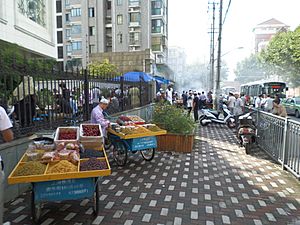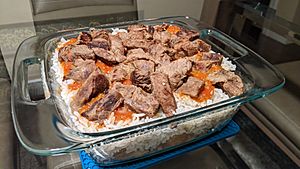Eid cuisine facts for kids
"Eid" is a special word in Islam that means "festival" or "celebration." Muslims around the world celebrate two main Eid festivals each year: Eid al-Fitr and Eid al-Adha. These are joyful times filled with prayers, family gatherings, and, of course, lots of delicious food! Each country and even different local areas have their own unique dishes that make Eid celebrations extra special.
Contents
Eid al-Fitr: The Sweet Celebration
Eid al-Fitr is often called the "Sweet Eid." This is because many sweet dishes are enjoyed after the holy month of Ramadan. Ramadan is a time of fasting and prayer, and Eid al-Fitr celebrates its happy end. Countries like Bangladesh, Brunei, Pakistan, Iran, Indonesia, India, Malaysia, and the Arab world all have their own sweet traditions.
Sweet Breakfasts and Desserts
For breakfast on Eid al-Fitr, people often eat sweet dishes. One popular dish is Boeber, made by cooking vermicelli (thin noodles) with dates in milk. Another similar dish, balaleet, is popular in the Persian Gulf region.
In the Middle East, many different desserts and cookies are made or bought. These include tasty treats like mammol, ghorabya, kahk, baklava, and kanafeh. You might also find halva and marzipan.
Sweet Dishes in South Asia
In South Asia, popular Eid sweets include sheer kurma, halwa, kheer, and Shahi tukda. Other favorites are Chomchoms, barfis, gulabjamuns, and different types of pithas. Roshmalai is also very popular. These sweets are enjoyed at home and shared with visiting friends and family.
In Sri Lanka, special treats include watalapam, kevum, dodol, gulab jamun, jelebi, kokies, and sheerkurma.
Main Meals and Other Regional Treats
While Eid al-Fitr is known for sweets, people also prepare savory dishes for lunch and dinner. These often include pulao (a rice dish), korma, kabab, and different curries. Biryani is another common and delicious rice dish.
In Turkey, people enjoy sweets like kanafe, Baklava, and Lokum. They also serve Tulumba, Chocolate, chips, candies, cookies, and cotton candy. Turkish coffee is often served too.
In Southeast Asian countries like Indonesia, Malaysia, Brunei, and Singapore, common Eid dishes include Ketupat (rice cakes), Lemang (sticky rice cooked in bamboo), and sweet Dodol. Savory dishes like Rendang (a rich meat stew), opor ayam (chicken in coconut milk), and sayur lodeh (vegetable stew) are also popular.
Eid al-Adha: The Savory Feast
Eid al-Adha is known as the "Salty Eid" because it features many savory dishes. This festival celebrates sacrifice and sharing. Families who can, sacrifice an animal like a cow or a sheep. The meat is then shared with family, friends, and those in need.
Meat Dishes and Sharing
For breakfast on Eid al-Adha, people often enjoy the fried liver of the sacrificed animal. Throughout the day, a wide variety of meat dishes are prepared. These include different kinds of kebabs (boneless meat, often grilled or fried), Nihari (a slow-cooked meat stew), haleem (a thick stew of meat and grains), Korma, and various curries.
Rice dishes are also very popular, especially in South Asia. You'll find different forms of pulao and Biryani, which are flavorful rice dishes cooked with meat.
Regional Specialties
In Turkey and some Balkan Muslim communities, a dish called Kokoreç is eaten. It is made from intestines and is very popular.
Fattah is another well-loved dish during Eid al-Adha in Egypt. It is made with lamb or beef, rice, toasted pita bread, and topped with a tasty garlic tomato sauce.




